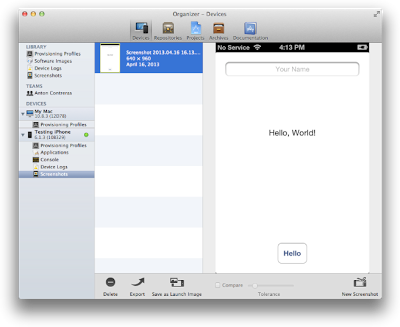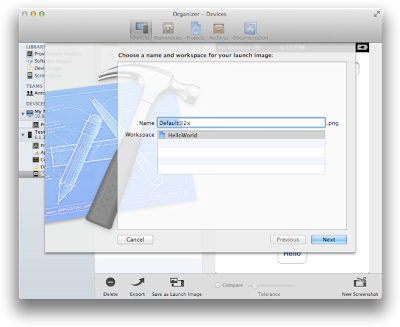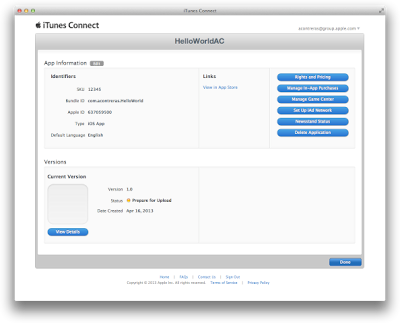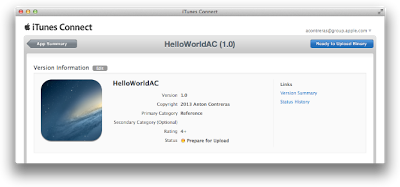When an app is sold in the App Store, the store displays a lot of information about the app, including its name, a description, an icon, screenshots, and contact information for your company. To provide that information, you log in to iTunes Connect, create a record for the app, and complete some forms. In this chapter you learn how to go through this process.
Note: Normally, you create your iTunes Connect app record late in the development process because there’s a time limit from when you create the record to when you must submit your app. However, some Apple technologies, including Game Center and In-App Purchase, require that an iTunes Connect record to be created earlier. For example, with In-App Purchase, you need to create the app record so that you can add the details of the items you want to sell. This content needs to be created before the development process is complete so that you can use it to test the code you added to implement In-App Purchase.
Before You Begin
Before you begin, make sure that you have these assets ready to enter into the forms:- The date when you want to ship your app (you can set the latest date allowed and change it later)
- A brief description of your app that iTunes will display to customers
- An app icon (512 x 512 pixels) ready for upload
- At least one screenshot of your app ready for upload
- An internal version number for your submission
- A bundle ID that you've set to match your app ID
- Capture screenshots.
- Set the launch image.
- Set your bundle ID.
Capture Screenshots
Using Xcode, you can capture screenshots of your app on a device and save the images on your desktop to upload to iTunes Connect later and use as a launch image.
To capture a screenshot on your device . . .
- Connect the device to your Mac.
- In Xcode, run your app on the device (as described in “To launch the app on the device”).
- Configure the app on the device the way you want it.
- In Xcode, open the Devices organizer.
- In the Devices section, click the disclosure triangle next to the iOS device.
- Select Screenshots .
- Click New Screenshot in the lower-right corner.
Set the Launch Image
Besides capturing screenshots, you should set a launch image that acts as a placeholder for your application’s user interface at launch time. Do this at the same time that you capture screenshots for iTunes Connect.
To set your launch image . . .
- In the Xcode Devices organizer, select the screenshot in the Screenshots folder of the Library section.
- Select “Save as Launch Image.”
After performing these steps, the corresponding launch image is set in the Summary pane in Xcode. For example, if the screenshot was captured on an iPhone 4, the screenshot now appears in the Summary pane as the Retina Display launch image in iPhone/iPod Deployment Info.
Set the Bundle ID to Match the App ID
The record in iTunes Connect also includes a field for a bundle ID; the value you place in this field must exactly match the bundle ID for the app. The app name and version you enter in iTunes Connect must also match the Xcode project configuration.You set the bundle ID for your app when you create your Xcode project as described in “Creating an Xcode Project.” For your convenience, the bundle ID defaults to a reverse-domain name using the company identifier followed by the product name that you entered when you created your Xcode project—for example,
com.charlestaylor.HelloWorld, where com.charlestaylor is the company identifier and HelloWorld is the product name. The bundle ID is actually set in theInfo.plist file of your Xcode project and can be changed to any identifier that follows the RFC 1034 specification.The bundle ID that you enter in iTunes Connect cannot be changed after the first version of your app is approved or you enabled some specialized technologies, such as iCloud storage or push notifications. Therefore, you should pick the final bundle ID for your app now.
To set your bundle ID in the Info.plist file . . .
- In the Xcode project navigator, select the project.
- Select your target in the Targets section, in the second column, to display the project editor.
- Click the Info tab.
- Enter the bundle ID in the Value column of the “Bundle identifier” row.
Create the iTunes Connect App Record
Next, you create the actual iTunes Connect app record and complete some forms. After you finish this process the status of your app is “Prepare for Download.” You need to answer additional questions about export compliance before the status changes to “Waiting for Upload.” The app record status needs to be at least “Waiting for Upload” to submit your app to the App Store.
To create an iTunes Connect app record . . .
- Log in to iTunes Connect (described in “To go to iTunes Connect”).
- Select Manage Your Applications.
- Complete the forms by inserting your app's information.
To complete the export compliance question . . .





Comments
Post a Comment